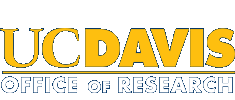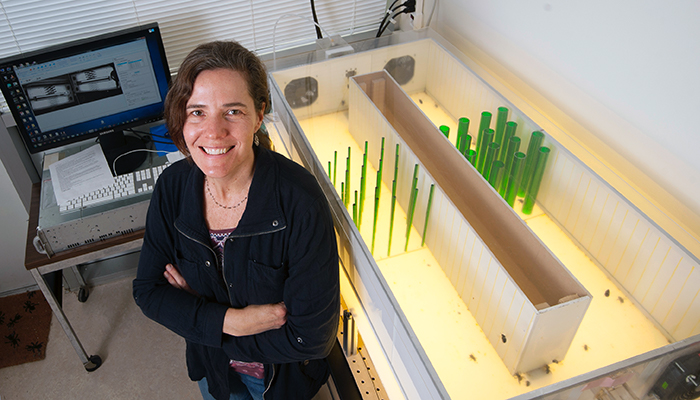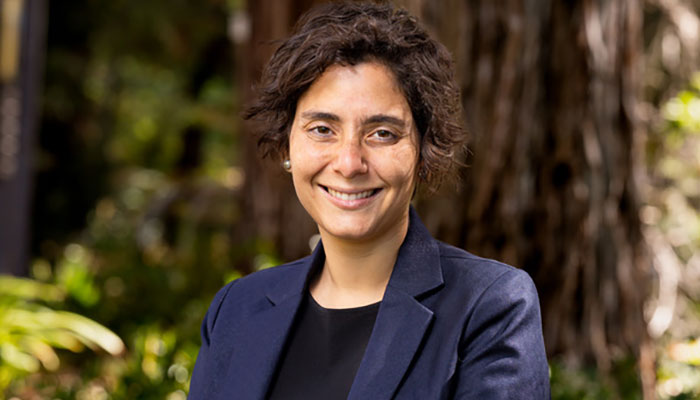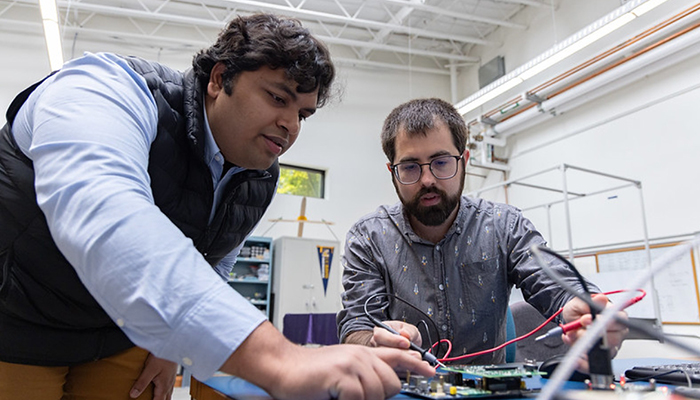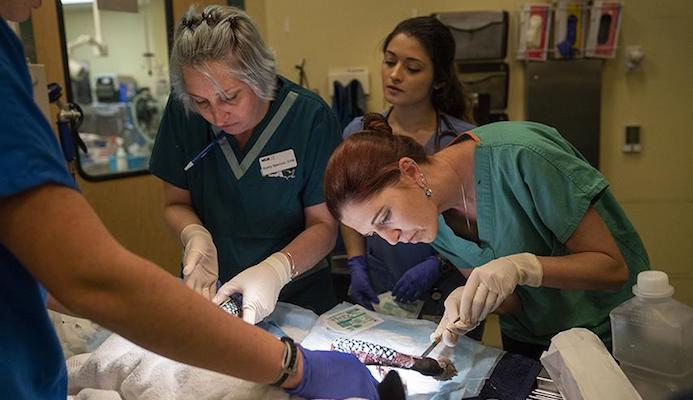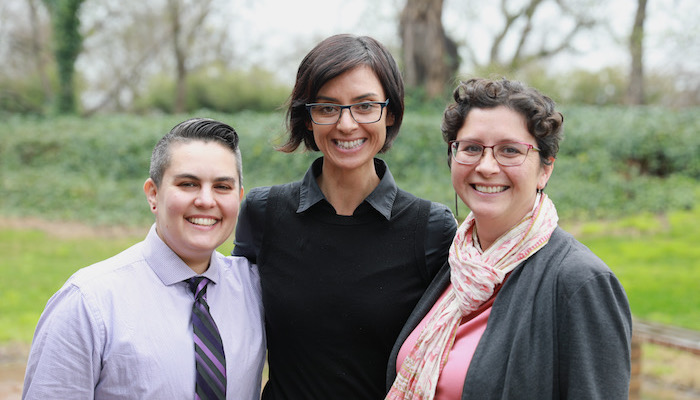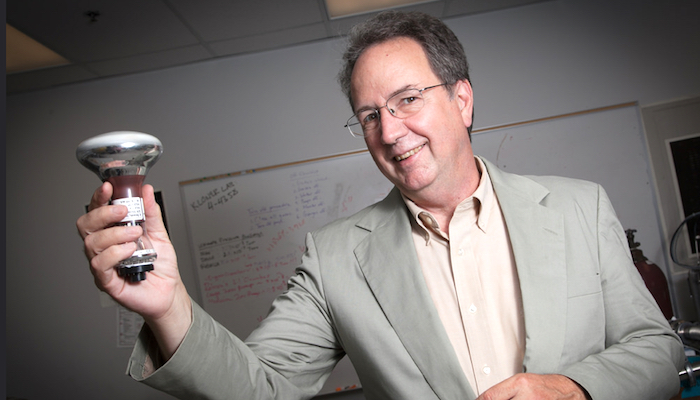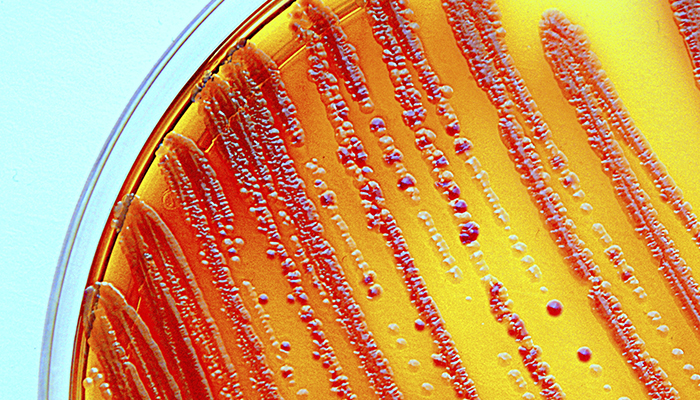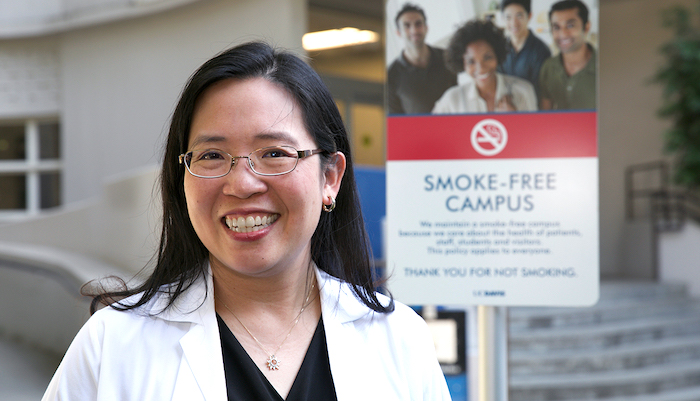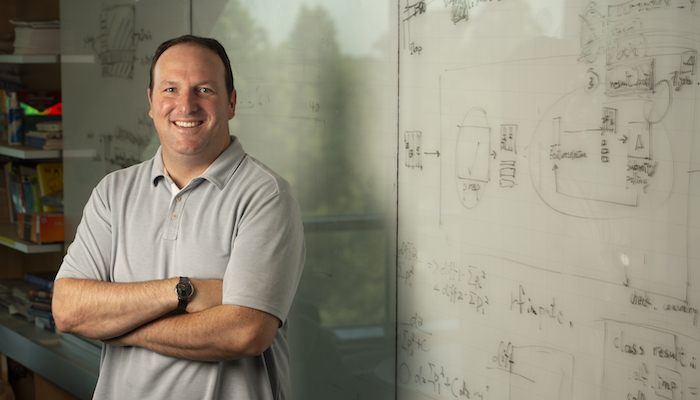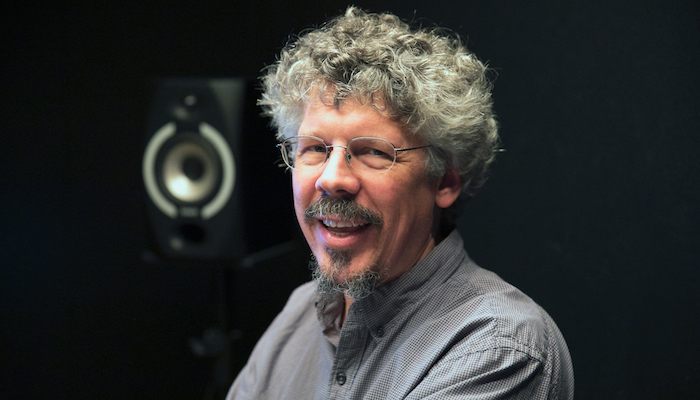Training a Bee to Fly Upwind: Stacey Combes’ Research Reveals the Complex Biomechanics that Help Insects Survive
By Lisa Howard
According to Stacey Combes, it’s not hard to train a bee to fly upwind in a wind tunnel. “They like certain colors and certain scents. And they like to feed.”
Combes is an associate professor in the Department of Neurobiology, Physiology, and Behavior at UC Davis. She recently moved into a new lab in Hutchison Hall, so there’s not much on the walls yet, and not much furniture in the offices. But the wind tunnel — about 20 feet long, and ranging from 2 to 5 feet wide in different sections — has already been assembled in the main part of the lab.
To train the bee, she explains, they remove it from a hive and let it wait in a cage for a few hours to make sure it’s hungry. “Then we put a fake purple flower that smells good and has nectar at the front of the wind tunnel. We place the bee on it, and show it that there’s nectar, and then take it to the other end.”
Sometimes the bees fly toward the fake purple flower right away. Sometimes they don’t. Sometimes the bee just walks around. So, they start the process again, putting the bee on the fake flower, giving it a taste of nectar, and then putting it back at the other end.
“Usually it just takes a few times until they learn, okay if I fly up there, there’s something to eat.”
The point of training bees to fly upwind in the wind tunnel is not simply to train them, but to capture their behavior — to capture images of the bees in flight.
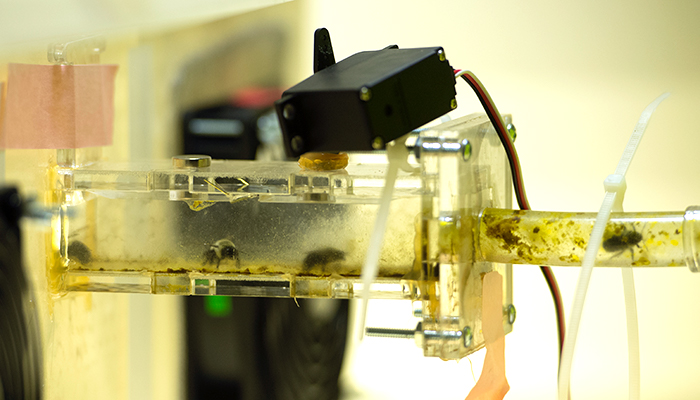
Bees in Stacey Combes lab at UC Davis. One thing Combes learned early on is that bees and other flying insects are quite clumsy. They bump into objects and other insects a lot. But it turns out some insects also have extremely elastic “joints” in the middle of their wings that allow the wings to bend along their length and be more robust to collusions. Combes explains that resilience means an insect can bump into something pretty hard — and pretty often — and still survive with its wings intact. (Karin Higgins/UC Davis)
Combes is a biomechanist — she studies the biomechanics of animals — and she’s equipped the wind tunnel with high-speed cameras that can take images up to the incredible speed of 300,000 frames per second. But, as she points out, at that speed, the resolution goes way down, and more light is needed.
“We usually film at 1,000 frames per second, or, if we are trying to do something really detailed on how the wings bend, maybe 5,000 frames per second,” Combes says. High-speed video is critical for a lot of Combes’ work — allowing her to see and analyze what cannot be captured by the human eye.
One thing she learned early on is that bees and other flying insects are quite clumsy. They bump into objects and other insects a lot. But it turns out some insects also have extremely elastic “joints” in the middle of their wings that allow the wings to bend along their length and be more robust to collisions. Combes explains that resilience means an insect can bump into something pretty hard — and pretty often — and still survive with its wings intact.
Bees are critically important pollinators, so for Combes, research from the wind tunnel and high-speed imaging is essential to understanding what affects their flight and ability to forage, particularly in a time when ecosystems are being reshaped by climate change. Some of her recently published studies looking at the different ways bees use their wings include “Foraging in an unsteady world: bumblebee flight performance in field-realistic turbulence,” and “Wings as impellers: honey bees co-opt flight system to induce nest ventilation and disperse pheromones.”
Combes has also extensively studied dragonflies. At Harvard, where she taught before UC Davis, she had an enclosure for dragonflies fitted with eight high-speed cameras. With the help of high-speed imaging, she and her fellow researchers were able to catch the aerial acrobatics of the dragonflies in the complex act of catching prey in mid-flight. They were also able to capture the behavior of their prey — fruit flies — which did not display evasive maneuvers in flight but did perform random, erratic turns that sometimes foiled the dragonflies. The speeded-down videos show the complex interactions between predator and prey, biomechanics and behavior.
“Dragonflies are huge predators of mosquitoes,” Combes says, so understanding how they hunt could have big implications for controlling mosquito populations.
An early interest in science
Combes grew up in the San Joaquin Valley, in Merced, and was very interested in science at an early age. There wasn’t an Advanced Placement Biology class at her high school. She rectified that by starting a petition and got the course added.
Combes attended UC Berkeley as a pre-veterinary student, pursing a degree in integrative biology. The class she credits as influencing her career the most, though, wasn’t related to veterinary sciences and didn’t even take place in Berkeley.
During her senior year, she spent a semester in Costa Rica participating in a field biology program with other University of California students. They traveled to different parts of the country and were stationed for a while in Monteverde, a cloud forest biological reserve known for its beauty and wide range of biodiversity.
Combes loved all of it, but she especially loved observing the behavior of the animals. “It was really cool. We would do one-day field studies. We would go around and collect all this data and would have to write up a paper every day.” Some of the studies were on plants, some insects. “I think that field biology program influenced me a lot even though at the time I wasn’t thinking I would really do research,” Combes says.
After she graduated from UC Berkeley in 1994 with a B.A. in integrative biology, Combes spent a year working for a veterinarian and gradually came to realize that it wasn’t the right career for her. She was still interested in how animals work — their anatomy and physiology – but she had become interested in an area known as physiological ecology, which looks at how animals adapt to different environments. She was reading studies like how cold or hot weather affect a lizard’s sprint speed.
She decided to go to graduate school at the University of Washington and worked with Tom Daniel, who studies the control and dynamics of animal locomotion. She worked on insect flight and fluid dynamics, which got then her into biomechanics.
“I was always kind of sucked in by the beauty of how an animal’s motion looks when you speed it down.” Combes received her Ph.D. in zoology from the University of Washington in 2002, and stayed two years as a postdoctoral researcher. She then spent three years pursuing her research at UC Berkeley on a prestigious Miller Fellowship.
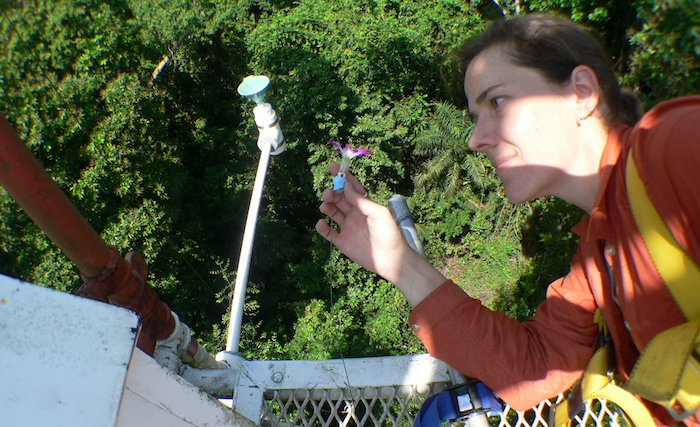
Stacey Combes setting scent bait for orchid bees and measuring air turbulence in Barro Colorado Island in Panama. As part of her post-doctoral work she did field work in Panama, which helped refocus her studies. “Even though I really like a lot of the math, the field work in Panama reminded me, this is what really inspires me, watching animals behave in nature.” (Photo courtesy of Stacey Combes)
Immersed in history on the East Coast
Combes began teaching at Harvard University in 2008. When she first moved to Cambridge, Massachusetts, she was struck by the area’s rich history.
“Before I moved to the East Coast I thought there would be a few old houses, maybe in Concord, but it’s really the whole town. Almost every single house is from the 1700s or 1800s,” Combes says. “In Cambridge, you can walk down the street to go to the grocery store and walk by a famous author’s house or by the house George Washington lived in when his troops were assembling in the square where you play with your kid.”
Combes’ research into the biomechanics of insect flight deepened at Harvard as she made discoveries about dragonfly flight. She enjoyed her colleagues. She had the luxury of teaching small classes — usually never more than 25 in a class. She won several teaching awards at Harvard, and also received the NSF Early Faculty Development (CAREER) Award in 2013.
But Cambridge never quite felt like home. Combes and her husband missed the West Coast and wanted to raise their son in California. “All our family is out here,” Combes says. “And part of it was that we really missed the West Coast — the people and the geography, the weather and everything.” They moved back to California in 2013, and until Combes started her teaching position at UC Davis in 2015, she commuted from Marin to Harvard.
Before arriving at UC Davis, Combes had never taught a large class. One of her first classes was the popular Neurobiology, Physiology, and Behavior 102, “Animal Behavior.”
“It’s big! The first time I taught it, there were 417 students,” Combes says. “It’s fun to teach. Students tend to like it especially if I find cool videos and relate them to what we are studying.”
One video that’s a hit with her students shows an animal’s understanding of the concept of fairness. In the video, one monkey is given a cucumber for doing a task and sees another monkey getting grapes (a favorite) for the same task. “The monkey getting the cucumber gets really angry,” Combes says.
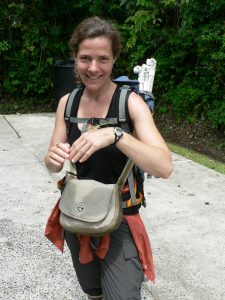
Stacey Combes with a
walking stick on Barro Colorado Island in Panama. As part of her post-doctoral work she did field work in Panama, which helped refocus her studies. “Even though I really like a lot of the math, the field work in Panama reminded me, this is what really inspires me, watching animals behave in nature.” (Photo courtesy of Stacey Combes)
She loves teaching the class. “I think animal behavior really inspires me although I didn’t consider that to be what I’m studying until recently. Some of our research is starting to go more in that direction. It’s all focused around how insects fly but one of our most recent experiments is a classic ‘two-choice’ behavior experiment.”
For the study, they gave a colony of bees the choice of flying either upwind or downwind to get out of the hive. A tailwind would seem to be preferred — like a jet getting a push from the jet stream making the flight easier.
They set up cameras and a computer to automatically trigger the cameras and record the data. “We got thousands and thousands of data points on all the bees — how much they pass through both tunnels going there and back,” Combes says. “It gave us a really definite answer. Which is that they actually like to fly upwind.”
Combes explains that it’s very hard for the bees to maintain stability with a tail wind. “They end up pitching up and down.”
Because Combes’ work has implications for mechanical engineering and animal behavior, she has collaborated with researchers from a variety of disciplines. She has collaborated with roboticists building robotic bees. She has submitted collaborative grants with geneticists studying fruit fly wing vein patterning, ecologists studying the effects of climate change on dragonfly dispersal, entomologists studying the effects of nutrition on bumblebee population dynamics, and evolutionary biologists studying anti-bat adaptations in the wings of moths. She’s also been getting together informally with a group of other researchers on campus who are all interested in pollination.
Combes is also part of a campus group to help women in STEM, Women in Life Sciences at Davis, or WILD. Although aimed at helping women, all gender identities are welcome. “It’s a meeting group that’s mostly female graduate students and postdocs and a few faculty. It’s kind of like a monthly lunch discussion group. We bring different speakers or we talk about different topics,” Combes says.
From her own experience, she knows that it can be hard for students to find the right niche. What at first seems like the right path — in her case veterinary medicine — doesn’t always turn out to be a good fit. In fact, Combes went so far as thinking about quitting academia after receiving her Ph.D. She felt like she had lost a sense of what inspired her. “The work I was doing was very computational. I was treating insect wings as beams, and using engineering equations, and doing computer modeling.”
But as part of her postdoctoral work she ended up doing field work in Panama, which helped refocus her studies. “Even though I really like a lot of the math, the field work in Panama reminded me, this is what really inspires me, watching animals behave in nature.” She adjusted her research to focus on the biomechanics of complex flight behaviors of dragonflies and bumblebees that allow them to survive in natural environments, combining her fascination with animal locomotion and structure with animal behavior and ecology.
“I’ve run into a lot of students who feel like they need to work in a lab for four years to show that they are really dedicated,” Combes says. “But when I’m looking at students applying to graduate school, I prefer to see people who have tried all kinds of different things and really explored what they like. I say, keep trying new things. Get a good amount of experience in each one but if you don’t fall in love with the first research experience, try something else.”
Contacts
- Lisa Howard, UC Davis Office of Research, [email protected]
- Stacey Combes, Department of Neurobiology, Physiology and Behavior, [email protected]
Resources
- Combes Lab
- For this flower, it’s ready, set, launch
- Gizmodo: Bumblebees Collide With Objects More Often Than You Think
- Study shows bumblebees fly differently depending on the load they are carrying
- Dragonflies: The flying aces of the insect world
Latest News & Events
